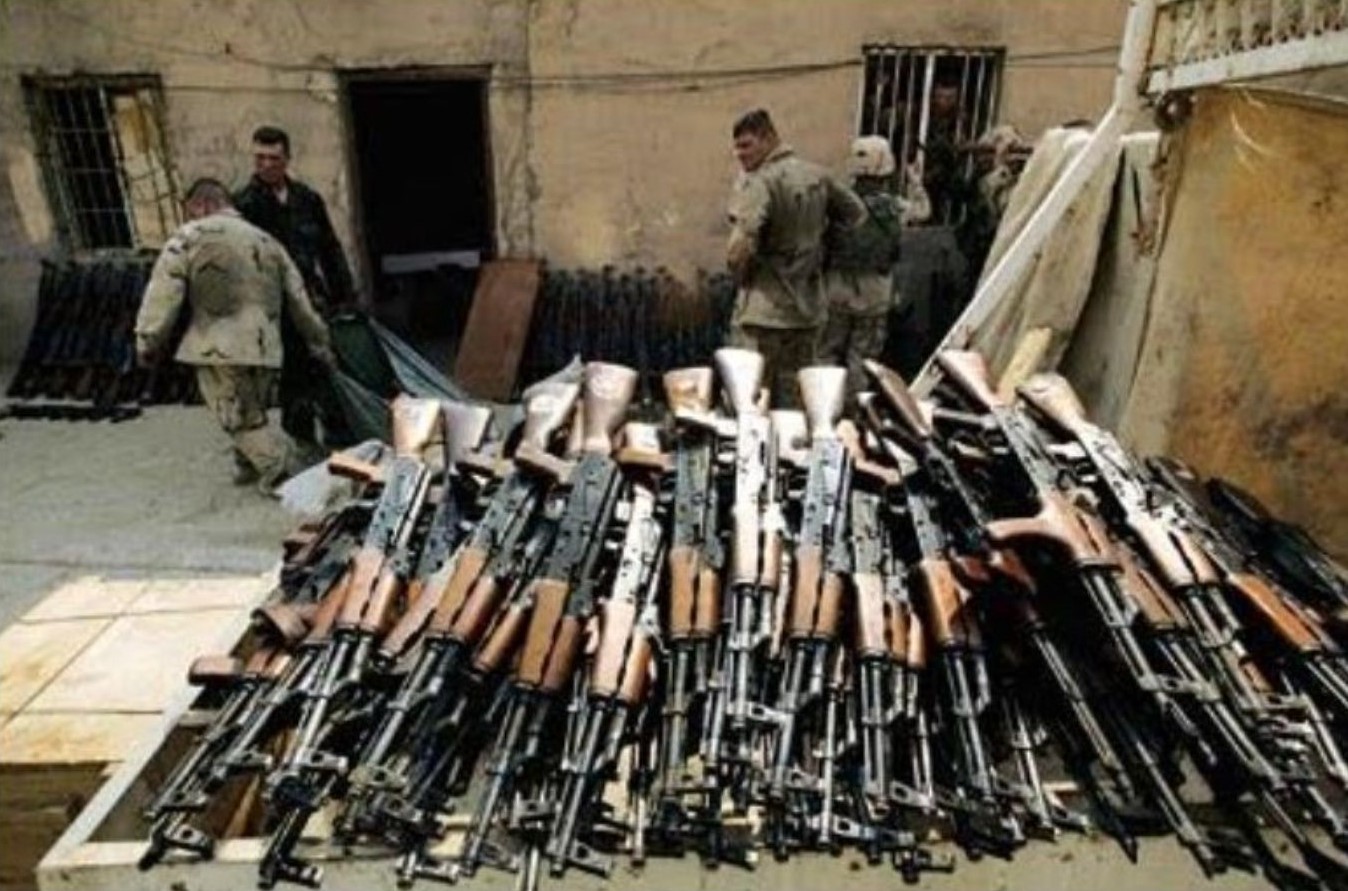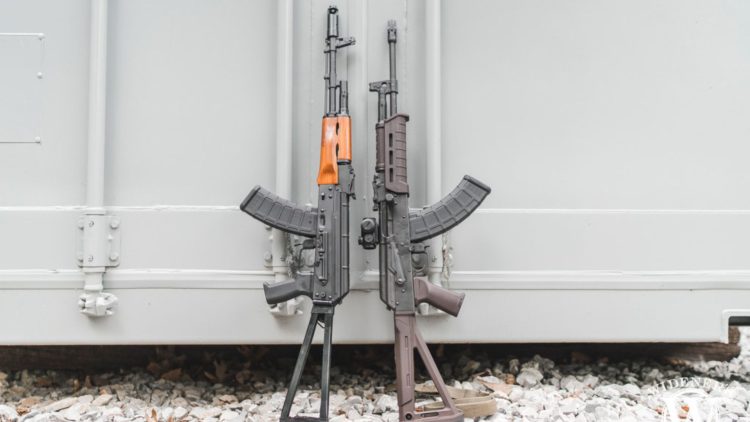The Avtomat Kalashnikova
If modern warfare takes place in a theater, one actor has continuously dominated the stage, captivating audiences with its relentless performance under the most dire conditions. The Avtomat Kalashnikova, or AK, is an undying symbol of resilience and brute force. The “47” part of the moniker comes from its first production year. You guessed it, 1947.
My personal journey with the AK-47 begins outside the hallowed gates of what used to be known as Fort Bragg, North Carolina. This is where I bought a slightly beat-up specimen from a short round man with a Russian accent. “Never fired, only dropped once!” he quipped, echoing a joke that was making its way around military circles at that time. It only cost a couple of hundred bucks, and that’s a good thing because that’s all the money I had.

This was in the days before the first Gulf War, and I had only ever handled one in training and orientation prior to that. Mine is in good company. A quick search reveals that some 100 million AK-47s and their variants have been made over the years. In many parts of the world, they are as common as ticks on a hound dog’s ass. This is with good reason; they are simple and effective tools of war.
Voyage Into the AK-47 Universe
My interest in the AK-47 did not stem merely from its ubiquity in those regions but also from the tales of its legendary reliability and accuracy. In the hands of our adversaries, it appeared to be an ever-reliable comrade, performing beyond expectation even under neglected maintenance and care. The rumor mills buzzed with stories of these weapons, barely cleaned for a decade, firing with deadly precision. The bad guys might not have been aiming, but the AK-47 didn’t seem to need much guidance. My curiosity now piqued, I embarked on a personal journey to explore the true nature of the AK-47. I was determined to assess its reliability and accuracy firsthand and discover why it has earned its formidable, rugged reputation.

Questioning Accuracy
A well-known characteristic of the AK-47, as I soon found out, is its relative lack of accuracy, especially when compared to other rifles or carbines like the M4/AR-15. However, my experience revealed a more nuanced picture. I found that the AK-47 was a decent enough weapon straight out of the shady gun store. Truth be told, I haven’t fired it in years. It had its day, though, and back when ammo was affordable, I put thousands of rounds downrange over the decades. Sure, it rattles a bit when you shake it, but that’s part of the charm. I shot about maybe a grapefruit-sized group (a large grapefruit) at 100 meters, and that’s good enough, I guess.
However, the accuracy of the AK-47 cannot be discussed without examining its construction and the ballistic coefficient of its projectile. The AK-47, a masterpiece of simplicity, has a large bolt that moves back and forth upon firing. This motion creates a significant disturbance in the weapon’s harmonics, which, in turn, affects accuracy. In English, it vibrates the shit out of it. The Kalashnikov is a clunky weapon; there’s just no other way to put it. In addition, depending on the weather conditions, the wooden handguard warps a bit, adding to its character.
The 7.62x39mm cartridge used by the AK-47 has a ballistic coefficient of approximately 0.275, which is less than the 5.56mm round fired by its classic American counterpart. The ballistic coefficient impacts the bullet’s ability to overcome air resistance in flight, consequently affecting the rifle’s accuracy by a little. No one ever claimed this was a long-range sniper rifle. Many long-range impacts on the enemy were by sheer “spray and pray” dumb luck.
An Unparalleled Symbol of Reliability
Despite these shortcomings in accuracy, the AK-47 shines in reliability.
They are the VW Beetle of weaponry. Hear me out on this one: Both the AK and the Beetle were designed with simplicity in mind. They are easy to use and maintain, even in harsh conditions. They were both durable and withstood rough treatment. Let’s consider mass production. Kalashnikovs and Beetles are among the most mass-produced items in their respective categories. Ever. Almost everyone has been in the presence of them and likely owned one or the other (or both) at some period. They are firmly ingrained in our history. And by “our” history, I mean human history. They have a ubiquitous presence and can be found in almost every corner of the globe.
My own AK-47 has been around a bit. It’s seen more mud than a rich lady at one of those high-end spas. It’s been roasted in the desert and frozen stiff in the Pennsylvania mountains in the wintertime (in the same month). It’s experienced monsoon season in Florida and gone overboard in a swamp. I think a gator may have even tried to chomp on it once. The results, to paraphrase one of those old Timex commercials, “It took a licking and kept on ticking”…err, shooting in this case. My maintenance consisted of wiping it down with a semi-oily rag from time to time. Yes, it got treated like the red-headed stepchild of my firearms collection.
Malfunctions, I’ve had a few, but then again, too few to mention (my apologies to Sinatra). Mostly failures to feed, likely due to a clapped-out magazine spring. Pop some rounds in a new magazine, and you’re good to go again. Pro tip: If you need a high-quality magazine for just about anything under the sun (including hard-to-find ones), check out my friends at GunMag Warehouse.
You have to give Russian engineer and soldier Mikhail Kalashnikov credit for designing such a robust weapon. The fewer parts needed for the weapon to operate means fewer places for dirt or foreign objects to interfere. The large clearances in the trigger mechanism and the design of the bolt allow for debris to easily fall away from crucial areas, letting the rifle function even in challenging conditions. The AK has been called charmingly simple and crudely strong. Pressed metal and wood, it doesn’t get more basic than that.
AK-47 Specifications
The Avtomat Kalashnikova is a gas-operated, rotating bolt rifle with a semi-automatic firing rate of 40 rounds per minute and a cyclic rate of 600 rounds per minute. It launches its 7.62mm rounds at a muzzle velocity of 715 m/s (2,350 ft/s). Although the effective range is stated as 350 meters (380 yds), for an experienced shooter, I would extend that to 480 on a silhouette target. The standard magazine capacity is 30 rounds, but magazines can range from a 10-round box to a 100-round drum. Don’t buy cheap magazines for your AK; you’ll just end up tossing them and buying better ones.
Conclusion: The Legend of the AK-47 Continues
The AK-47 may not be the most accurate weapon, but its tenacity and resilience make it an invaluable asset in the theatre of war. Its ability to function in adverse conditions with minimal maintenance is a testament to its superior design. The indomitable AK-47, with its robust construction and reliable performance, remains an icon, a symbol of resistance, and a testament to the ingenuity of its designer. It’s no surprise then that the AK-47 continues to be a preferred choice for many, a tribute to its enduring popularity and influence. It is not merely a weapon; it’s a legend, continually etching its story in the annals of military history.
Origins and Evolution of the AK-74
Both the AK-47 and AK-74 hail from Russia, designed by Mikhail Kalashnikov. If the AK-47 came out around 1947 guess what year the AK-47 replaced it? That’s right, 1974-ish. A.D. Kryakushin’s design group designed the AK-74 under the direct supervision of Mikhail Kalashnikov himself. The 74 uses the same core system as the 47. They are father and son.

Design Comparison
Structural Differences
The AK-74 introduced several new features: a revamped stock, handguard, and gas cylinder. The stock sports a rubber shoulder pad with serrations for better grip. Weight-reducing cuts adorn the sides of the buttstock.
Additionally, the AK-74’s gas tube incorporates a spring washer at its rear end for a more secure fit. The lower handguard includes a leaf spring that minimizes lateral play, enhancing stability. All exposed metal parts boast a glossy black enamel coating.
Power and Caliber
Remember, the AK-47 fires a 7.62x39mm round, packing a punch with kinetic energy of around 2100 Joules and muzzle velocities of 730 meters per second. Enhanced versions can even reach 3300 Joules with longer barrels.
Conversely, the AK-74 uses a 5.45x39mm round, producing about 1400 Joules of energy at speeds up to 890 meters per second. This difference impacts performance in various environments; the AK-47’s rounds are more reliable in diverse battlefield conditions, whereas the AK-74’s rounds are more likely to be deflected by obstacles like grass or glass.
Barrel and Muzzle
The AK-74’s barrel is chrome-lined with a 200 mm (1:8 inch) rifling twist rate and includes a redesigned gas block and front sight base.

The front sight base features a threaded collar for attaching a multifunction muzzle device, which serves as a muzzle brake, recoil compensator, and flash suppressor. This device’s design helps manage muzzle climb and lateral movement, especially for right-handed shooters.
Magazines and Weight
The AK-74 and AK-47 magazines differ slightly in dimensions to accommodate their respective cartridges. AK-74 magazines, typically made of durable polymer, include a raised rib on the rear lug to prevent their use in 7.62x39mm AKs.
The weight difference is notable: the AK-74 weighs in at 3.03 kg (6.7 lbs), significantly lighter than the AK-47, which weighs 4.3 kg (9.5 lbs). The AK-74’s lightest variant, the AKS-74U, weighs only 2.5 kg (5.5 lbs), making it more manageable and portable. These weight reductions and material enhancements contribute to the AK-74’s improved ergonomics and ease of use.
Cost and Manufacturing
The AK-74 is more cost-effective to produce on a mass scale compared to the AK-47. Its affordability, combined with ease of manufacturing and consistent, reliable performance, has made it a widely used firearm.
The AK-74’s design improvements over the AK-47 include a lighter weight, reduced recoil, and better accuracy, enhancing its appeal to various military forces.
Additionally, the use of polymer components in the AK-74’s construction reduces production costs and increases durability. These factors contribute to the AK-74’s extensive adoption by numerous countries and its continued popularity in modern military arsenals.
Popularity and Distribution
The absence of copyright or patent controls allowed any country or manufacturer to produce AK-47 and AK-74 variants. This freedom, combined with the rifles’ durability, ease of use, and cost-effectiveness, led to their proliferation. An estimated 100 million AK-47s are in circulation today.
Ergonomics and Accessories
The AK-74 boasts several ergonomic improvements over the AK-47. Its compensator reduces recoil, making the weapon more controllable. With holes on the top and sides, the compensator diverts gases to mitigate recoil. The stock is longer and more comfortable, better fitting larger individuals and absorbing recoil with a rubber buttpad.

The handguard on the AK-74 is longer and ribbed for better grip and heat resistance, featuring side rails for attaching accessories like flashlights, lasers, and optics. The AK-74’s magazines, made of plastic, are lighter and more durable than the AK-47’s metal magazines, resistant to rust.
The Future of the AK-74
While the AK-74 hasn’t achieved the same iconic status as the AK-47, it remains a formidable weapon with notable improvements. Recently, its popularity has surged among gun enthusiasts in the United States, who value its unique features such as reduced recoil and enhanced accuracy.
The AK-74’s reliability and performance have garnered a dedicated following. Several American manufacturers have begun producing AK-74 rifles, increasing their availability and accessibility in the market. This growing interest highlights the AK-74’s standing as a modern, effective firearm, appreciated for both its historical significance and practical advantages.
Final Verdict
The AK-47 is the rugged workhorse of the battlefield, famed for its durability and simplicity, while the AK-74 takes that foundation and refines it with improved ergonomics and accuracy. Though the AK-74 might not have the same legendary status, it’s increasingly appreciated for its lighter, more controllable nature, especially among modern gun enthusiasts. Both weapons symbolize reliable firepower, but the AK-47’s legacy as a global icon remains unmatched.
Disclaimer: SOFREP utilizes AI for image generation and article research. Occasionally, it’s like handing a chimpanzee the keys to your liquor cabinet. It’s not always perfect and if a mistake is made, we own up to it full stop. In a world where information comes at us in tidal waves, it is an important tool that helps us sift through the brass for live rounds.









